The best touring bike is the bike you roll out of the garage on and set off for new horizons – you really can travel on any bike! For Ireland however, I have a few recommendations for you…
Page Contents (click line to jump the text)
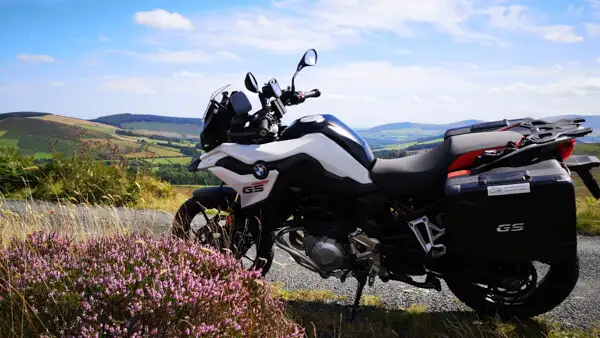
Intro
And with that, I could keep this article very short and end it here. Thank you very much for your attention! 😊
But if you already have several motorbikes in your garage, or if you have the choice of which motorbike to rent for your upcoming trip to Ireland, then I have a few recommendations for you below.
By the way, I have already done many motorbike tours with different motorbikes. Originally from Germany, my family and I have been living in Ireland (second home) for several years. and we had our own motorcycle rental shop here for a number of years, too.
But now back to the question of the best touring motorbike:
Summary for quick readers
The best touring motorbike for the Ireland trip is a mid-sized touring enduro. Good suspension travel and a large front wheel improve comfort on bad roads. A moderate seat height and well-tread tyres add safety on rolling gravel or gravelled car parks. Engine power is not critical because of the low cruising speeds in Ireland.
And now again in full detail. I have been travelling for many years and many thousands of kilometres on a wide variety of motorbikes from cruisers to enduros. After all these experiences, I have come to the following conclusions….
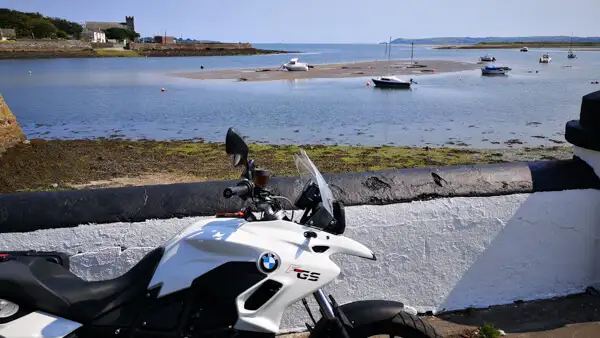
Criteria for a good touring motorbike
- the motorbike is comfortable enough for long days in the saddle.
- the engine response is pleasant, even after many hours.
- the response of the clutch and brakes is good and predictable at all times.
- the suspension and chassis can cope with a full load without any problems.
- the exhaust sound is not distracting or stressful even after hours.
- the fuel tank capacity and consumption allow longer trips on a single tank.
- sufficient luggage can be attached to the motorbike.
- good comfort for rider and passenger even in 2-person operation.
- the motorbike is reliable and requires little maintenance when travelling.
- the motorbike suits the riding conditions in the country of travel.
- the motorbike suits the rider and can be safely controlled by the rider.
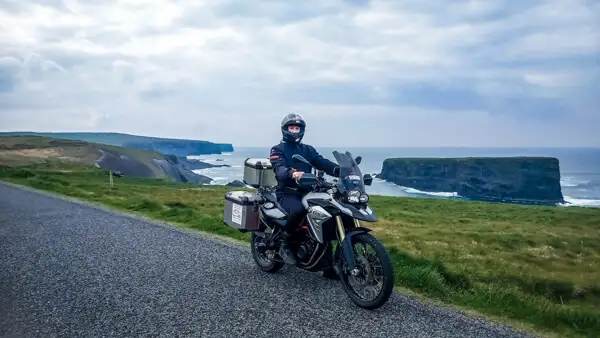
Let’s take a closer look at the individual topics:
1) The motorbike is comfortable enough for long days in the saddle.
Which motorcyclist doesn’t know the feeling: after two hours of riding, your backside hurts, your knees ache and your back is complaining. A short time later, a stiff neck comes along, followed by an unpleasant headache – motorbike trips are fun?
Yes, if the ergonomics are right: The seat triangle, i.e. the distance between the handlebars, footrests and seat must correspond to the size of the rider, then a lot is already helped. The motorbike industry builds motorbikes according to men’s standard sizes, so if you are between 178cm and 183cm tall, most motorbikes will fit you from the factory.
For taller and heavier riders, thicker and wider padded comfort seats, a handlebar riser and lowering the footpegs if necessary will help. Smaller riders benefit from deep or extra-deep seats and, if necessary, a handlebar offset that brings the handlebars closer to the rider.
Some bikes don’t need much modification at all, e.g. the Honda Africa Twin 1100 or the Yamaha Tenere 700 already fit taller riders very well from the factory, and the BMW G310GS can also be ridden well by a smaller, lighter-built female rider.
If you choose a motorbike that fits well to the rider’s size or adjust an existing one ergonomically well, you can effortlessly spend long distances in the saddle and really enjoy your motorbike holiday!

2) The engine response is pleasant, even after many hours.
Like a cat of prey in a jump, my high-horsepower machine shoots forward – so much acceleration, so much riding fun!
After a few hours on bumpy small country roads, it does get annoying: the big cat jumps off every time the throttle hand wobbles, and on the bumpy roads it becomes increasingly difficult to keep the hands steady…
A linear response of the engine and a “tolerant” throttle grip help to keep the ride calm. If you have a motorbike with riding modes, you can switch from dynamic mode to rain mode, even if it’s not raining. The smoother response of the rain mode is definitely pleasant. Be careful with the off-road modes, however, as the ABS may be reduced or switched off at the rear wheel, which is not the best choice on asphalt.
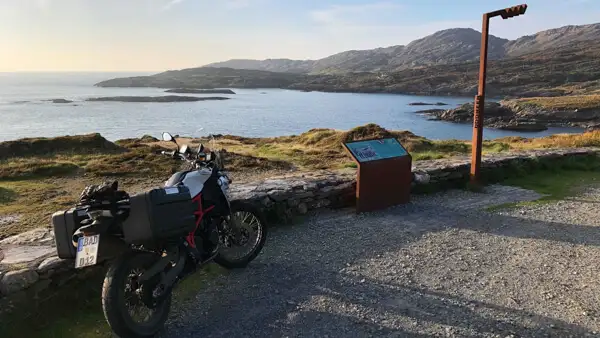
3) The response of the clutch and brakes is good and predictable at all times.
On the home track the brakes are great, but after hours the fingers hurt and the clutch engagement becomes increasingly jerky – what to do? Often the distance of the brake lever from the handgrip does not match the size of the rider’s hand – adjustable hand levers provide a remedy and reduce finger fatigue on long rides.
The same applies to the clutch lever. When choosing a motorbike, pay attention to how much force the hand levers require and whether they can be dosed well.
4) Suspension and chassis can cope with a full load without any problems.
This is by no means a matter of course, even on modern motorbikes! Especially with so-called “entry-level motorbikes”, manufacturers save on the price – understandably – and thus also on the cost of the components. Suspension and swingarm, as well as main and rear frame are somewhat simpler and cheaper.
What is not noticeable on a test ride (alone) often becomes noticeable when riding with a pillion passenger and/or fully loaded with luggage: The bike floats and swings and does not feel very safe. The bike becomes too light at the front, contact with the road deteriorates and precise cornering turns into a wobbly line. Potholes quickly hit the rider’s and passenger’s backs. Braking distances also become unpleasantly long when the bike is loaded.
The entry-level motorbike is therefore not bad and usually well suited for one person and not too much luggage, but perhaps not the best choice for a trip for two and with a lot of luggage. If in doubt, rent (or borrow or buy) a category higher, i.e. more expensive, then riding fun and safety are also guaranteed for two.
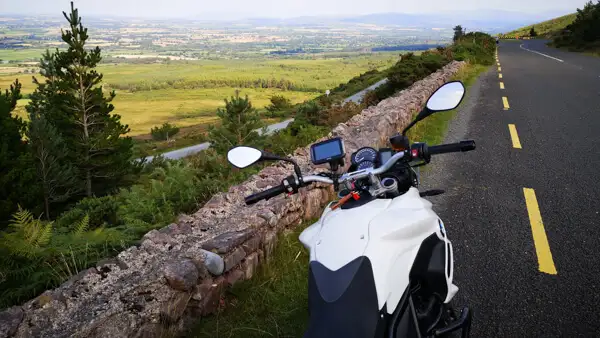
5) The exhaust sound is not annoying or stressful even after hours.
Cool aftermarket exhaust, it really roars! I speak from my own experience, the V-Twin Cruiser with “cool exhaust” led to a headache after a few hours. The thing was simply much too loud. Some time later, a high-revving four-cylinder: the turbine whispers gently at idle, but very soon starts to whistle just above idle and then “screeches” unpleasantly at higher revs. After a while, the high sound frequencies really got on my nerves.
The sound is more important than many people think, and on tour, a little annoying sound is especially helpful. A low hum has a calming effect, high sound frequencies have a rather activating effect on the nervous system. Often, the supposedly boring Euro 5-compliant standard exhausts turn out to be a blessing on tour!
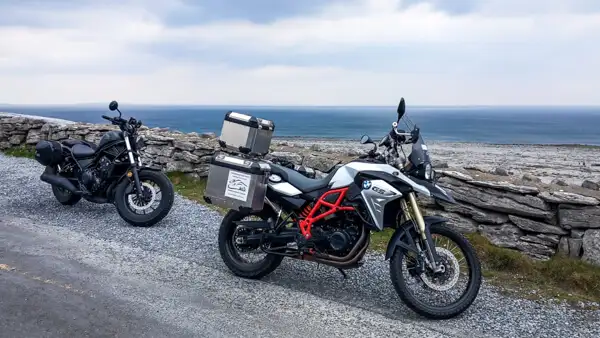
6) Tank capacity and consumption allow longer stages with one tank filling.
Exactly, it’s about tank AND consumption. If the tank only has a volume of 12 litres and the bike only consumes 3 litres/100 km, you can still go up to 400 km on one tankful – at least in theory. Fully loaded and on the motorway, that’s maybe 250 km, and in mixed touring mode maybe 280-330 km.
When travelling, it makes a lot of sense to refuel in good time before the reserve message lights up. This saves your nerves when the next two petrol stations only exist in the navigation system or are closed on Sundays.
My tip: If you subtract about 30% from the manufacturer’s range specifications, you’ll be about right in mixed travel mode. Even in Western Europe, you should realistically have at least 250-300 km of range available to be able to travel relaxed and effectively.
7) Sufficient luggage can be attached to the motorbike.
This is actually self-explanatory, but not all motorbikes can be fitted with luggage systems equally well. Often the exhaust is in the way, for example on retro scamblers where the exhaust is very high on one side.
The manufacturer does not offer good luggage systems for every motorbike, and accessory manufacturers also concentrate on models where larger order quantities can be expected. If you ride alone, you can almost always strap a tank bag in front of you and a luggage roll behind you. For two people you need more volume and therefore a motorbike for which carrier systems for large side cases and a large top case are available.

8) Good comfort for rider and passenger even with 2-person operation.
When all the luggage is finally stowed, there should still be enough room for the rider and passenger. This includes two well-padded and well-fitting seats and the possibility of leaving a little space between the two people.
On a brisk home round, the close snuggle is still ideal in terms of driving dynamics, but on long tours everyone needs a bit of “privacy”. Otherwise, the repeated thudding of the pillion visor on the back of the rider’s helmet quickly becomes a test for the togetherness.
A shocking number of motorbikes offer very poor pillion comfort with poor rear seat cushions. Sometimes the luggage system also restricts the ascent or the panniers press into the back of the passenger’s knees. The only thing that helps here is: try it out, and try it out with two people!
9) The motorbike is reliable and requires little maintenance when travelling.
Most modern motorbikes fulfil this wish very well. The maintenance interval is usually at or above 10,000km and if the motorbike starts on tour freshly serviced, there should be no surprises.
Fresh oil, fresh tyres, a freshly lubricated chain (and chain spray with it) and a generally roadworthy condition of the motorbike help to start the holiday relaxed and also to end it relaxed.
Those who ride more exotic motorbike brands should check before the trip whether there are also specialist dealers of this motorbike brand in the destination country, because otherwise ordering a spare part in an emergency can be difficult.
There are experienced motorbike mechanics who like to travel with “antique” motorbikes and the travel reports are then full of successfully mastered roadside repairs.
Don’t misunderstand, an older motorbike can also be reliable if it is well maintained! And for me it can be, because I want to experience the country and the people on my trip and not have to worry too much about the motorbike.

10) The motorbike is suitable for the riding conditions in the destination country.
Tyres and wheels: Today, large, heavy and high-powered touring enduros in particular are often equipped with so-called 90/10 tyres as standard. These should cover 90% road use and 10% (light) off-road use, which suits most riders and riding conditions.
In some countries, however, even non-off-road drivers often come across rolling gravel, dirt on the road or gravelled large parking areas. In Ireland, for example, this is very often the case. Here it might also make sense to fit an 80/20 or 70/30 tyre, which offers more safety on loose ground due to its coarser tread.
Furthermore, larger wheels with a diameter of 19 or 21 inches roll better over potholes and road damage than smaller wheels with a diameter of 17 inches.
In such road conditions, a sufficiently good suspension with long suspension travel is also very helpful. Most touring enduros and hybrid tourers are well equipped in this respect.
Wind protection: Am I going south or north? Do I need protection from the cold and wet or will it be hot? Will I be riding a lot on the motorway or mainly on smaller country roads? Motorbike wind protection can be both a curse and a blessing. If you ride a lot, you might buy a high and a low windshield for your bike and then switch accordingly depending on the riding conditions.
Also important: The windshield should not cause turbulence on the helmet. A smaller and lower windshield may be the better choice. Otherwise, add-on spoilers from the accessories trade can be a remedy.
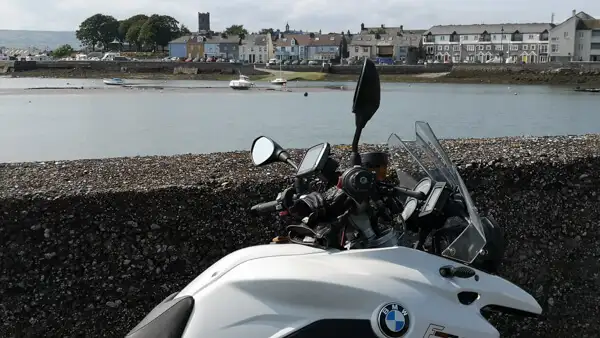
11) The motorbike fits the rider and can be safely controlled by the rider.
Size and weight of the bike: It’s nice if the top-class touring enduro has 130-170 hp – but this usually means a high weight of 250-280 kg, not counting the pillion and luggage. The saddle is high, the ground is far beneath the feet and when turning, the rider loses his balance … gravity works reliably again today!
Standing, manoeuvring and turning safely on uncertain ground is extremely important when travelling. The slightly lighter motorbike with the slightly lower seat height can be the better option. And how much horsepower do I really need on my journey?
Conclusion
The ideal touring motorbike is as individual as the riders themselves. And it is wonderful that there is so much variety among motorbikes!
For me personally, the medium-sized touring enduro is the bike of choice. Engine power is less important to me than the criteria mentioned above. A medium touring enduro is manageable even in more difficult conditions and still remains easy to control at the end of the riding day when exhaustion sets in.
When I ride with a pillion, I prefer (as a taller rider) the bigger (and heavier) touring enduro – because of the comfort. But I find myself no longer turning into every narrow and impassable path with the big behemoths and thinking more often about how I’m actually going to turn the heavy bike around on single-lane roads if necessary. This limits my urge to explore a bit – which is a shame.
So bigger is not always better, and so for me personally the medium-sized touring enduro remains my preferred – best – touring motorbike.
I wish you many great journeys with your personal best motorbike!
More interesting articles for you
WHAT IS CHEAPER – TO RIDE YOUR OWN MOTORBIKE TO IRELAND FROM GERMANY, OR TO BOOK A FLIGHT AND RENT A MOTORBIKE IN IRELAND?
PACKING AND EQUIPMENT TIPS FOR MOTORBIKE TOURING IN IRELAND
IRELAND MOTORBIKE TOUR – 24 BEAUTIFUL BEACHES ON THE WILD ATLANTIC WAY
THE 13 MOST BEAUTIFUL MOTORBIKE TOURS ON THE IRISH ISLAND
Photo credits cover photo: Motorbike at Fanad Pensinula, photo by Ulrich Knüppel-Gertberg (www.irland-insider.de, www.ireland-insider.com)